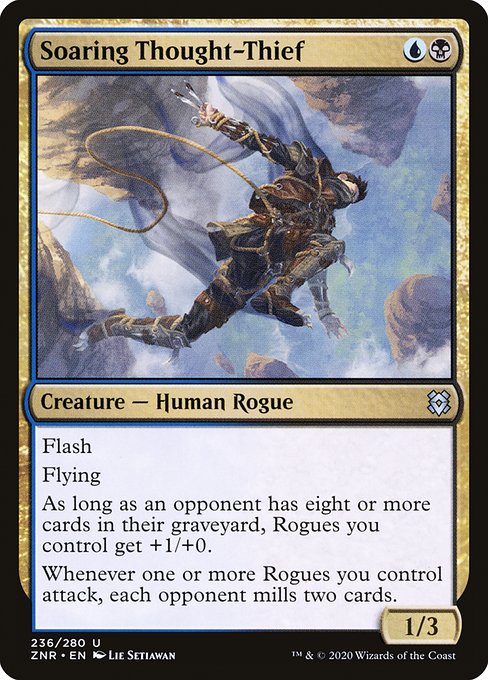
Image courtesy of Scryfall.com
Depth and Perspective in Soaring Thought-Thief
Magic: The Gathering art has a language all its own, and Soaring Thought-Thief speaks it fluently. Painted for Zendikar Rising by Lie Setiawan, this blue-black creature embodies a quick-left-field heist: a Rogue who threads through air and intention with the effortless ease of a memory slipping from a graveyard. The moment the eye lands on the composition, you’re invited to trace how perspective unfolds—from the sharp, shadowed foreground to the receding storm of blues that swallow the distance. It’s a study in depth that rewards slow, deliberate looking as much as it rewards swift, tactical play on the battlefield 🧙♂️💎.
Two-color tension and the illusion of space
The card’s color identity—blue and black—narrates a tension between control and consequence. In the artwork, that tension becomes a visual rhythm: cool blues curling around a darker core, with hints of cyan and indigo that push the eye backward, suggesting depth. The Rogue’s flash of motion suggests a near-instant entry into the scene, a classic trick of perspective where a figure stepping into frame makes the surrounding air feel thicker, heavier with possibility. The flying keyword literally elevates the subject, but the real depth comes from how the surrounding architecture—the implied ceiling of the sky and the suggestion of distant threats—retreats into darker tones, creating a sense of space that extends beyond the card’s borders 🔎🎨.
Fore, mid, and far: layering for spatial clarity
In many MTG artworks, depth is conveyed through layering: a crisp foreground element, a middle-ground action, and a distant, often softly rendered background. Soaring Thought-Thief follows that through-line with a nimble balance. The rogue in the foreground is rendered with sharper edges and more contrast, making the figure pop against a hazier, receding backdrop. This use of atmospheric perspective—where distant elements lose contrast and warmth—helps the viewer read the scene at a single glance, even as we might zoom in to appreciate the micro-details like the glint of a blade’s edge or the ripple of fabric along the cloak. The result is a dynamic composition that feels as if the viewer could lean forward and join the thief in mid-air, a perfect echo of the card’s tempo on the table ⚔️.
Lighting as a map of intention
Lighting in this piece isn’t merely cosmetic; it’s a storytelling map. The light source—coming from the upper left—casts a subtle glow along the rogue’s path, sharpening the edge where air meets intention. Where the foreground is crisp, the background dissolves into cooler hues, guiding your gaze toward the attacker’s next move and the mill-forward mechanic baked into the card’s text. In a static image, this lighting creates a narrative of suspense and potential outcomes—much like the card’s own effects that hinge on timing, attack, and the opponent’s graveyard state 🔥🧭.
Mechanics and the art of depth: how the card’s power grows with the graveyard
Soaring Thought-Thief isn’t just a pretty face in a stylish cloak. Its abilities—Flash and Flying—make it a surgical tool for skirting blockers and slipping under radar. The flavor of its depth deepens with the mechanic line: “As long as an opponent has eight or more cards in their graveyard, Rogues you control get +1/+0. Whenever one or more Rogues you control attack, each opponent mills two cards.” The art mirrors this sense of layered depth. The rogue isn’t merely flying; they’re exploiting a chain of distant consequences, a narrative echo that you feel even before you resolve combat. In practice, it invites a deck-building mindset: you set up mill-enabling lanes, then drop a surprise flyer that raises the stakes for your opponent’s next draw step. The combination of mild incremental power and a disruptive mill win-conditions makes the artwork’s depth a perfect analogue for the card’s strategic depth 🧠🎲.
From palette to play: the art as a guide for deck building
For players who adore Dimir-inspired rogues or any blue-black synergy, the visual language of this piece reinforces why Soaring Thought-Thief fits neatly into Commander and various eternal formats (while also being off the standard meta rails). The contrast between the cool palette and the shadowed, cunning silhouette echoes the tonal vibe of planning—silently scoping the battlefield, calculating who to mill, and when to flash in a threat that changes the pace of the game. The art’s depth invites you to imagine not just the moment of entry, but the long game—the way a few well-timed hits can tilt mid-to-late-game boards into your favor 💎⚔️.
Artistic craft and collector’s eye
Lie Setiawan’s illustration carries a signature line—clean outlines, expressive eyes, and a careful balance of motion and stillness—that makes Soaring Thought-Thief a standout piece in Zendikar Rising. The set’s uncommon slot feels earned by a design that rewards detail-oriented viewing: the careful edge-work, the subtle glint on the blade, and the way the cloak folds in mid-air. For collectors, the nonfoil and foil options provide two different textures for enjoying depth: the foil can intensify the light-induced glints that travel across the rogue’s silhouette, while nonfoil renders the moody atmosphere with a softer, more cinematic feel. The card’s playstyle synergy—flying rogues that mill—also makes it a neat centerpiece for any blue-black rogue-themed collection 🧙♂️💎.
Product spotlight
To keep the magic in your daily life outside the battlefield, check out this practical crossover promotion: a phone case designed for durability and style that mirrors the careful care you bring to your decks. Clear Silicone Phone Case: Durable, Flexible, Slim
More from our network
- https://blog.digital-vault.xyz/blog/post/metastatic-evangel-memes-infectious-laughs-in-mtg/
- https://crypto-acolytes.xyz/blog/post/hot-blue-giant-at-338-kpc-illuminates-milky-way-scale/
- https://blog.digital-vault.xyz/blog/post/from-idea-to-income-print-on-demand-and-digital-hybrid-shop/
- https://transparent-paper.shop/blog/post/nearby-solar-analogs-versus-a-blue-white-beacon-at-274-kpc/
- https://crypto-acolytes.xyz/blog/post/how-cloud-gaming-is-redefining-access-and-play/